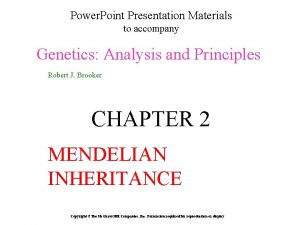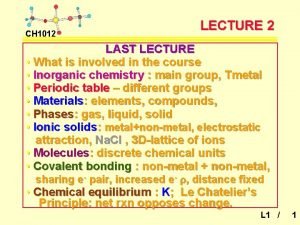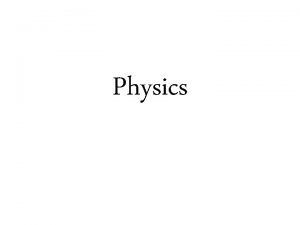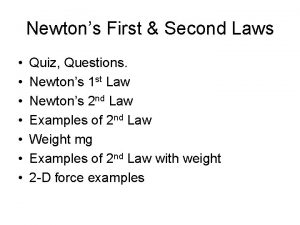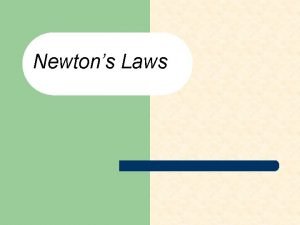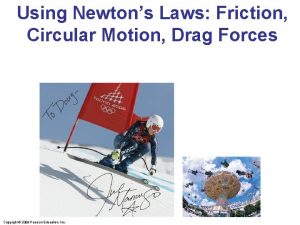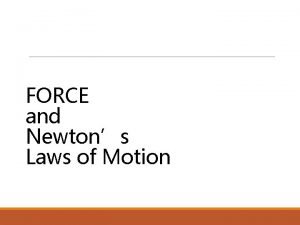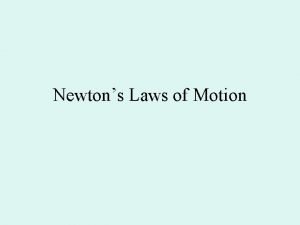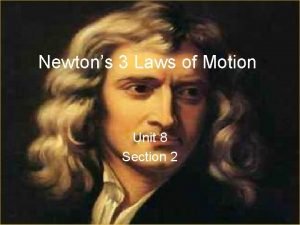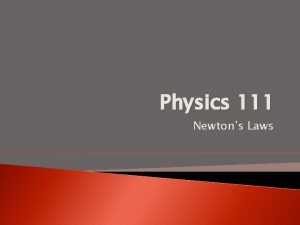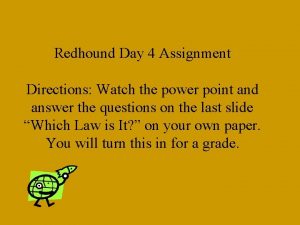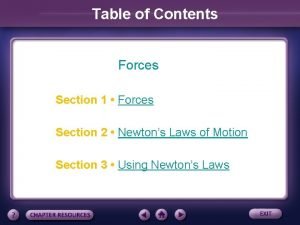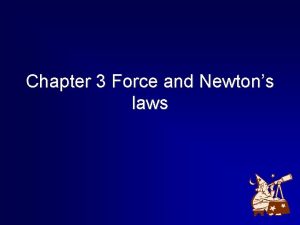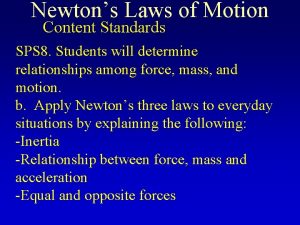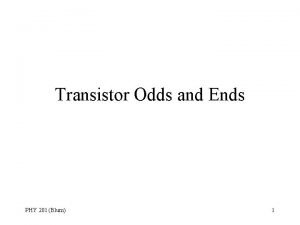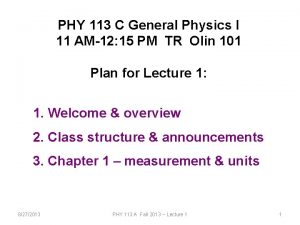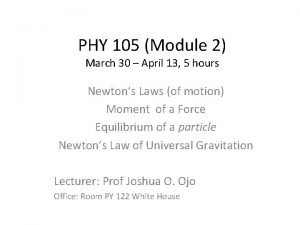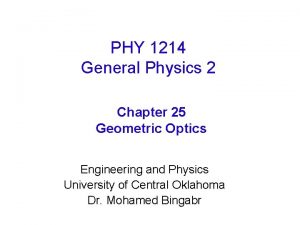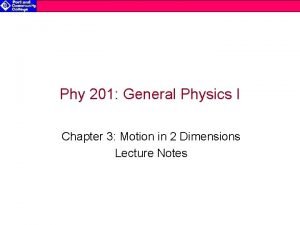NEWTONS LAWS PHY 1012 F Kinematics Gregor Leigh


































































- Slides: 66

NEWTON’S LAWS PHY 1012 F Kinematics Gregor Leigh gregor. leigh@uct. ac. za CONCEPTS OF MOTION

PHY 1012 F NEWTON’S LAWS CONCEPTS OF MOTION KINEMATICS Learning outcomes: At the end of this chapter you should be able to… Interpret, draw and convert between position, velocity and acceleration graphs for 1 -d motion. Use an explicit problem-solving strategy for kinematics problems. Apply appropriate mathematical representations (equations) in order to solve numerical kinematics problems involving motion in one dimension. 2

PHY 1012 F NEWTON’S LAWS CONCEPTS OF MOTION IN ONE DIMENSION We shall standardise on the following sign conventions: The positive end of the x-axis points to the right; The positive end of the y-axis points upwards. y x 3

PHY 1012 F NEWTON’S LAWS CONCEPTS OF MOTION IN ONE DIMENSION We shall standardise on the following sign conventions: Positions left of the y-axis have negative x values; Positions right of the y-axis have positive x values. Positions below the x-axis have negative y values; Positions above the x-axis have positive y values. x < 0; y > 0 x > 0; y > 0 y x < 0; y = 0 x = 0; y > 0 0 x x > 0; y < 0 x < 0; y < 0 4

PHY 1012 F NEWTON’S LAWS CONCEPTS OF MOTION IN ONE DIMENSION We shall standardise on the following sign conventions for representing directions: Vectors pointing to the right (or up) are positive; Vectors pointing to the left (or down) are negative. y x NB: The signs represent the directions. The magnitudes of vectors can never be negative! 5

PHY 1012 F NEWTON’S LAWS CONCEPTS OF MOTION IN ONE DIMENSION In 1 -d the relationship between acceleration and velocity simplifies to… When is zero, velocity remains constant. If and have the same sign, the object is speeding up. If and have opposite signs, the object is slowing down. 6

PHY 1012 F NEWTON’S LAWS CONCEPTS OF MOTION The slope at a point on a position-vs-time graph of an object is A B C D E the object’s speed at that point the object’s acceleration at that point the object’s average velocity at that point the object’s instantaneous velocity at that point the distance travelled by the object to that point 7

PHY 1012 F NEWTON’S LAWS CONCEPTS OF MOTION POSITION GRAPHS Plotting a body’s position on a vertical axis against time on the horizontal axis produces a position-vs-time graph, or position graph… 1 frame per minute 0 100 200 300 x (m) 400 200 0 0 2 4 6 t (min) 8

PHY 1012 F NEWTON’S LAWS CONCEPTS OF MOTION POSITION GRAPHS Plotting a body’s position on a vertical axis against time on the horizontal axis produces a position-vs-time graph, or position graph… 1 frame per minute 0 100 200 300 x (m) 400 200 0 0 2 4 6 t (min) 9

PHY 1012 F NEWTON’S LAWS CONCEPTS OF MOTION INTERPRETING POSITION GRAPHS It is essential to remember that motion graphs are abstract representations of motion – they are NOT pictures! The following graph represents the motion of a car along a straight road… Describe the motion of the car. x (km) During the first 30 min the value of xofchanges from 20 +10 At t =car 0 the car is 10 km to for the right origin. The After 40 30 min reaches min the car the starts stops origin moving once 10 back more min at tothe atathe 80 position right. min. km to the 20 left km, ofindicating the origin. that the car is moving to the left. 10 0 20 40 60 80 t (min) – 10 – 20 10

PHY 1012 F NEWTON’S LAWS CONCEPTS OF MOTION UNIFORM MOTION Straight-line motion in which equal displacements occur during any successive equal-time intervals is called uniform motion. s (m) Motion diagram: Position graph: 6 4 2 0 t = 6 s s = 4 m t (s) 0 2 4 6 11

PHY 1012 F NEWTON’S LAWS CONCEPTS OF MOTION UNIFORM MOTION Straight-line motion in which equal displacements occur during any successive equal-time intervals is called uniform motion. s (m) Motion diagram: Position graph: 6 4 2 0 t = 4 s s = 6 m t (s) 0 2 4 6 An object’s straight line motion is uniform if and only if its velocity vx (or vy) is constant and unchanging. 12

PHY 1012 F NEWTON’S LAWS CONCEPTS OF MOTION POSITION GRAPHS OF UNIFORM MOTION Body A is travelling to the right at constant speed… x (m) A t (s) Body B is… travelling to the left/right and is going slower/faster than A. B t (s) (Assume same axes scales. ) 13

PHY 1012 F NEWTON’S LAWS CONCEPTS OF MOTION POSITION GRAPHS OF UNIFORM MOTION Summary: Zero slope zero velocity. (Object is stationary. ) Steeper slopes faster speeds. Negative slope negative velocity (ie vx is left/vy is down). The sign (negative or positive) refers only to the direction of the velocity, and has nothing to do with its magnitude. 14

PHY 1012 F NEWTON’S LAWS CONCEPTS OF MOTION POSITION GRAPHS OF UNIFORM MOTION Summary: Zero slope zero velocity. (Object is stationary. ) Steeper slopes faster speeds. Negative slope negative velocity (ie vx is left/vy is down). The sign (negative or positive) refers only to the direction of the velocity, and has nothing to do with its magnitude. The slope is a ratio of intervals, x/ t, not coordinates, x/t. Remember: Position graphs are abstract representations! We are concerned with the physically meaningful slope [in m/s], not the actual slope of the graph on paper. 15

PHY 1012 F NEWTON’S LAWS CONCEPTS OF MOTION x (m) 6 4 2 0 t (s) 0 1 2 3 4 Describe carefully (and quantitatively) the motion of the basketball player depicted by this position graph. 16

PHY 1012 F NEWTON’S LAWS CONCEPTS OF MOTION THE MATHEMATICS OF UNIFORM MOTION s (m) sf s si t (For uniform motion) t (s) ti tf The velocity of a uniformly moving object tells us the amount by which its position changes during each second. 17

PHY 1012 F NEWTON’S LAWS CONCEPTS OF MOTION MULTI-REPRESENTATIONAL PROBLEM-SOLVING Bob leaves home in Chicago at 09: 00 and travels east at a steady 100 km/h. Susan, 680 km to the east in Pittsburgh, leaves at the same time and travels west at a steady 70 km/h. Where will they meet? Pictorial representation: Bob 0 (x 0)B, (vx)B, t 0 (ax)B = 0 (ax)S = 0 (x 1)B, (vx)B, t 1 (x 1)S, (vx)S, t 1 (x 0)B = 0 km (vx)B = +100 km/h (x 0)S = +680 km (vx)S = – 70 km/h t 0 = 0 h x (x 0)S, (vx)S, t 0 t 1 is when (x 1)B = (x 1)S (x 1)B = ? 18

PHY 1012 F NEWTON’S LAWS CONCEPTS OF MOTION MULTI-REPRESENTATIONAL PROBLEM-SOLVING Bob leaves home in Chicago at 09: 00 and travels east at a steady 100 km/h. Susan, 680 km to the east in Pittsburgh, leaves at the same time and travels west at a steady 70 km/h. Where will they meet? Physical representation: Chicago meet Pittsburgh 19

PHY 1012 F NEWTON’S LAWS CONCEPTS OF MOTION MULTI-REPRESENTATIONAL PROBLEM-SOLVING Bob leaves home in Chicago at 09: 00 and travels east at a steady 100 km/h. Susan, 680 km to the east in Pittsburgh, leaves at the same time and travels west at a steady 70 km/h. Where will they meet? Graphical representation: x (km) Susan 600 400 200 0 Bob 0 tmeet t (h) 20

PHY 1012 F NEWTON’S LAWS CONCEPTS OF MOTION MULTI-REPRESENTATIONAL PROBLEM-SOLVING Bob leaves home in Chicago at 09: 00 and travels east at a steady 100 km/h. Susan, 680 km to the east in Pittsburgh, leaves at the same time and travels west at a steady 70 km/h. Where will they meet? sf = si + vs t Mathematical representation: (x 1)B = (x 0)B + (vx)B(t 1 – t 0) = (vx)Bt 1 (x 1)S = (x 0)S + (vx)S(t 1 – t 0) = (x 0)S + (vx)St 1 They meet when (x 1)B = (x 1)S i. e. (vx)Bt 1 = (x 0)S + (vx)St 1 (x 1)B = (vx)Bt 1 = 100 km/h 4. 0 h = 400 km east of Chicago 21

PHY 1012 F NEWTON’S LAWS CONCEPTS OF MOTION INSTANTANEOUS VELOCITY Adjusting the time interval between “movie frames” of the horizontally orbiting tennis ball alters the average velocity vectors and the information they convey… 22

PHY 1012 F NEWTON’S LAWS CONCEPTS OF MOTION INSTANTANEOUS VELOCITY Adjusting the time interval between “movie frames” of the horizontally orbiting tennis ball alters the average velocity vectors and the information they convey… The longer the time interval, the less “real” the representation: (Especially if the “background” information is removed. ) 23

PHY 1012 F NEWTON’S LAWS CONCEPTS OF MOTION INSTANTANEOUS VELOCITY Conversely, the shorter the time interval, the more the vectors tend to show us what the ball is really doing – rather than merely depicting “average” behaviour for that time interval. As t gets smaller and smaller, approaches a limit – a constant value representing the instantaneous velocity at that point in time. Mathematically: 24

PHY 1012 F NEWTON’S LAWS CONCEPTS OF MOTION DERIVATIVES The limit, , is called the derivative of s with respect to t. In general (using an arbitrary function as a template), if u = ctn, to find the derivative of u (with respect to t)… ctnn– 1 1. Multiply the expression by the existing index. 2. Subtract 1 from the index. The derivative of a sum is the sum of the derivatives: E. g. i. e. 25

PHY 1012 F NEWTON’S LAWS CONCEPTS OF MOTION INSTANTANEOUS VELOCITY The same process of shrinking the time interval to determine the instantaneous velocity at one particular time can also be applied to linear motion. In this case, however, it is more helpful to make use of a position graph rather than a motion diagram… 26

PHY 1012 F NEWTON’S LAWS CONCEPTS OF MOTION INSTANTANEOUS VELOCITY The motion diagram represents an object whose speed is NOT constant, but increases uniformly each second: 1 frame per second s (m) 0 2 4 6 8 10 12 14 16 s (m) (Plotting uniformly accelerated motion against time results in a parabolically-shaped position graph. ) 16 12 8 4 t (s) 0 0 2 4 6 8 27

PHY 1012 F NEWTON’S LAWS CONCEPTS OF MOTION INSTANTANEOUS VELOCITY The ratio gives the average velocity, , for that particular time interval, represented graphically by the slope of the dotted line. s (m) The larger t, the less detailed the information… s s t s t t t (s) 28

PHY 1012 F NEWTON’S LAWS CONCEPTS OF MOTION INSTANTANEOUS VELOCITY Conversely, if we let the time interval either side of time t shrink towards the limit ( t 0), we get the instantaneous velocity at time t. s (m) On a position graph this corresponds to the slope of the tangent to the curve at time t. Mathematically: t (s) t 29

PHY 1012 F NEWTON’S LAWS CONCEPTS OF MOTION INSTANTANEOUS vs AVERAGE VELOCITY Note that (for uniform acceleration) the average velocity for a whole time interval is the same as the instantaneous velocity at time t in the middle of the s (m) interval… …as illustrated by the parallel slopes of the dotted lines on the position graph. t (s) t 30

PHY 1012 F NEWTON’S LAWS CONCEPTS OF MOTION POSITION GRAPHS VELOCITY GRAPHS Velocity is equivalent to the slope of a position graph. x (m) E. g. A car travels along a straight road… 10 0 – 10 – 20 x 2 4 6 8 t (s) t For the first 3 s the slope velocity is vx (m/s) 5 0 2 4 6 8 t (s) – 10 31

PHY 1012 F NEWTON’S LAWS CONCEPTS OF MOTION POSITION GRAPHS VELOCITY GRAPHS Velocity is equivalent to the slope of a position graph. x (m) E. g. A car travels along a straight road… 10 0 t (s) – 10 Between 3 s and 4 s the slope velocity – 20 is 2 4 6 8 vx (m/s) 5 0 2 4 6 8 t (s) – 10 32

PHY 1012 F NEWTON’S LAWS CONCEPTS OF MOTION POSITION GRAPHS VELOCITY GRAPHS Velocity is equivalent to the slope of a position graph. x (m) E. g. A car travels along a straight road… 10 0 2 4 6 t (s) 8 – 10 x – 20 Between 4 s and 8 s the slope velocity is t vx (m/s) 5 0 2 4 6 8 t (s) – 10 33

PHY 1012 F NEWTON’S LAWS CONCEPTS OF MOTION POSITION GRAPHS VELOCITY GRAPHS Velocity is equivalent to the slope of a position graph. x (m) E. g. A car travels along a straight road… 10 0 2 4 6 8 t (s) – 10 – 20 For the first 3 s the slope velocity increases steadily from zero to 7 m/s. vx (m/s) 8 4 0 2 4 6 8 t (s) 34

PHY 1012 F NEWTON’S LAWS CONCEPTS OF MOTION POSITION GRAPHS VELOCITY GRAPHS Velocity is equivalent to the slope of a position graph. x (m) E. g. A car travels along a straight road… 10 0 2 4 6 8 t (s) – 10 – 20 From 3 s to 6 s the slope velocity remains a steady 7 m/s. vx (m/s) 8 4 0 2 4 6 8 t (s) 35

PHY 1012 F NEWTON’S LAWS CONCEPTS OF MOTION POSITION GRAPHS VELOCITY GRAPHS Velocity is equivalent to the slope of a position graph. x (m) E. g. A car travels along a straight road… 10 0 2 4 6 8 t (s) – 10 – 20 Between 6 s and 7 s the slope velocity quickly decreases to 0… …and remains there. vx (m/s) 8 4 0 2 4 6 8 t (s) 36

PHY 1012 F NEWTON’S LAWS CONCEPTS OF MOTION THREE-MINUTE PAPER On a smallish piece of paper (which you’re going to fold in half), answer the following questions: What have you learnt so far? What still confuses you the most? Are you having fun? (If not, why not? !) 37

PHY 1012 F NEWTON’S LAWS CONCEPTS OF MOTION FINDING POSITION FROM VELOCITY In the previous chapter we showed that a body’s position can be determined from its velocity using. Graphically, the change in position ( s = v t) is given by the area “under” a velocity graph: During the time interval 2 s to 8 s the body travels a distance vs (m/s) 8 v 4 0 t 2 4 6 8 t (s) 38

PHY 1012 F NEWTON’S LAWS CONCEPTS OF MOTION FINDING POSITION FROM VELOCITY In the previous chapter we showed that a body’s position can be determined from its velocity using. Graphically, the change in position ( s = v t) is given by the area “under” a velocity graph: vs (m/s) 8 4 0 s 1 2 s 3 s 2 4 6 8 t (s) Even if the velocity varied (uniformly) during the time interval, s could still be determined by summing the “bits”: 39

PHY 1012 F NEWTON’S LAWS CONCEPTS OF MOTION FINDING POSITION FROM VELOCITY If the velocity varies non -uniformly during the interval… …we can approximate the motion with a series of constant velocity intervals. The total area under the graph is approximately vs (m/s) (vs)1 (vs)2 ti s 1 s 2 t t tf t (s) 40

PHY 1012 F NEWTON’S LAWS CONCEPTS OF MOTION FINDING POSITION FROM VELOCITY Once again we apply calculus, shrinking the t’s to obtain more and more accurate approximations… vs (m/s) until, as t 0, s 1 ti s 2 s 3 s 4 tf t (s) So 41

PHY 1012 F NEWTON’S LAWS CONCEPTS OF MOTION INTEGRALS is called the integral of vs dt from ti to tf. Since it has two definite boundaries (ti and tf), it is known as a definite integral. In general (using an arbitrary function as a template), The integral of a sum is the sum of the integrals: 42

PHY 1012 F NEWTON’S LAWS CONCEPTS OF MOTION DIFFERENTIATION AND INTEGRATION FOR DUMMIES To differentiate u = ctn … ctnn– 1 1. Multiply the expression by the existing index. 2. Subtract 1 from the index. To integrate u = ctn … ctn +1 1. Add 1 to the index. 2. Divide the expression by the new index. 3. Evaluate the integral at the upper limit, and. . . 4. subtract the lower limit value of the integral. 43

PHY 1012 F NEWTON’S LAWS CONCEPTS OF MOTION FINDING POSITION FROM VELOCITY A body which starts at position xi = 30 m at time ti, moves according to vx = (– 5 t + 10) m/s. Where does the body turn around? At what time does the body reach the origin? vx (m/s) 10 0 2 4 6 t (s) – 10 – 20 44

PHY 1012 F NEWTON’S LAWS CONCEPTS OF MOTION FINDING POSITION FROM VELOCITY A body which starts at position xi = 30 m at time ti, moves according to vx = (– 5 t + 10) m/s. Where does the body turn around? At what time does the body reach the origin? and Substitute t = 2 and solve for x. Substitute x = 0 and solve for t. 45

PHY 1012 F NEWTON’S LAWS CONCEPTS OF MOTION VELOCITY GRAPHS ACCELERATION GRAPHS Acceleration is equivalent to the slope of a velocity graph. vx (m/s) E. g. A car travels along a straight road… 6 0 3 6 9 12 t (s) – 6 ax For the first 6 s the slope acceleration is (m/s 2) 1 0 3 6 9 12 t (s) – 1 – 2 46

PHY 1012 F NEWTON’S LAWS CONCEPTS OF MOTION VELOCITY GRAPHS ACCELERATION GRAPHS Acceleration is equivalent to the slope of a velocity graph. vx (m/s) E. g. A car travels along a straight road… 6 0 3 6 9 12 t (s) – 6 ax For the last 6 s the slope acceleration is (m/s 2) 1 0 3 6 9 12 t (s) – 1 – 2 47

PHY 1012 F NEWTON’S LAWS CONCEPTS OF MOTION SUMMARY OF GRAPHS OF MOTION Constant +ve velocity Increasing +ve velocity s s t vs vis t as Decreasing +ve velocity s t t vs vfs vs vis vfs t as as 0 0 t t t 48

PHY 1012 F NEWTON’S LAWS CONCEPTS OF MOTION SUMMARY OF GRAPHS OF MOTION Constant –ve velocity Increasing –ve velocity s s t vs 0 t as s t vs vis t vfs t t vs vfs t vis as 0 0 Decreasing –ve velocity as t 0 t 49

PHY 1012 F NEWTON’S LAWS CONCEPTS OF MOTION KINEMATIC EQUATIONS OF CONSTANT a By definition, Hence: vfs = vis + as t vs (m/s) vfs vis ti ½as( t)2 vs = as t vis t tf t (s) sf = si + area under v-graph between ti and tf. Hence: sf = si + vis t + ½as( t)2 And, substituting t = (vfs – vis )/as: vfs 2 = vis 2 + 2 as s 50

PHY 1012 F NEWTON’S LAWS CONCEPTS OF MOTION PROBLEM-SOLVING STRATEGY FOR CONSTANT ACCELERATION KINEMATICS PROBLEMS Use the particle model. Make simplifying assumptions. Draw a physical representation (motion diagram). Draw a pictorial representation. Draw a graphical representation if appropriate. Use a mathematical representation (using the equations of motion with appropriately modified subscripts) to solve. Assess your solution: Is it complete? Is it reasonable? 51

PHY 1012 F NEWTON’S LAWS CONCEPTS OF MOTION A student is running at a constant speed of 5 m/s in an attempt to catch a Jammie Shuttle. When she is 11 m from the bus, it pulls away with a constant acceleration of 1 m/s 2. From this point, how long does it take her to catch up to the bus if she keeps running with the same speed? Physical representation: x 52

PHY 1012 F NEWTON’S LAWS CONCEPTS OF MOTION A student is running at a constant speed of 5 m/s in an attempt to catch a Jammie Shuttle. When she is 11 m from the bus, it pulls away with a constant acceleration of 1 m/s 2. From this point, how long does it take her to catch up to the bus if she keeps running with the same speed? Physical representation: x 53

PHY 1012 F NEWTON’S LAWS CONCEPTS OF MOTION A student is running at a constant speed of 5 m/s in an attempt to catch a Jammie Shuttle. When she is 11 m from the bus, it pulls away with a constant acceleration of 1 m/s 2. From this point, how long does it take her to catch up to the bus if she keeps running with the same speed? Pictorial representation: 0 (ax)W (x 0)W, (v 0 x)W, t 0 (x 0)J, (v 0 x)J, t 0 (ax)J (x 1)J, (v 1 x)J, t 1 (x 1)W, (v 1 x)W, t 1 x (m) (x 0)W = 0 m (v 0 x)W = (v 1 x)W = +5 m/s (ax)W = 0 m/s 2 (x 1)W = (x 1)J = ? (ax)J = +1 m/s 2 (v 1 x)J = ? (x 0)J = +11 m (v 0 x)J = 0 m/s t 0 = 0 s t 1 = ? is when (x 1)W = (x 1)J 54

PHY 1012 F NEWTON’S LAWS CONCEPTS OF MOTION A student is running at a constant speed of 5 m/s in an attempt to catch a Jammie Shuttle. When she is 11 m from the bus, it pulls away with a constant acceleration of 1 m/s 2. From this point, how long does it take her to catch up to the bus if she keeps running with the same speed? Graphical representation: x (m) 40 30 20 J 10 W 0 t (s) 55

PHY 1012 F NEWTON’S LAWS CONCEPTS OF MOTION A student is running at a constant speed of 5 m/s in an attempt to catch a Jammie Shuttle. When she is 11 m from the bus, it pulls away with a constant acceleration of 1 m/s 2. From this point, how long does it take her to catch up to the bus if she keeps running with the same speed? Mathematical representation: sf = si + vis t + ½as( t)2 (x 1)W = (x 0)W + (v 0 x)W t + ½ (ax)W t 2 = 0 + 5 t + (½ 0 t 2) = 5 t (x 1)J = (x 0)J + (v 0 x)J t + ½ (ax)J t 2 = 11 + 0 t + (½ 1 t 2) = 11 + ½t 2 She catches the shuttle when (x 1)W = (x 1)J i. e. 5 t = 11 + ½t 2 – 5 t + 11 = 0 t = 3. 3 s or t = 6. 7 s 56

PHY 1012 F NEWTON’S LAWS CONCEPTS OF MOTION FREE FALL The motion of a body moving under the influence of gravity only, and no other forces, is called free fall. (We often ignore air resistance for slow-moving, massive objects. ) Consequently… Two objects dropped from the same height in the absence of air resistance will hit the ground simultaneously, at the same speed. Any two objects in free fall experience the same acceleration, . 57

PHY 1012 F NEWTON’S LAWS CONCEPTS OF MOTION FREE FALL Notes: g = 9. 80 m/s 2 is magnitude of the acceleration due to gravity. It is therefore never negative! In our convention, afree fall = –g. g = 9. 80 m/s 2 is the average value for the surface of the Earth. “Free fall” refers also to objects which have been projected upwards – not only to those which are literally falling downwards. 58

PHY 1012 F NEWTON’S LAWS CONCEPTS OF MOTION FREE FALL y y 1, v 1 y, t 1 A kingfisher hovers 30 m directly above a boy with a catapult. If the boy launches a stone straight up at 25 m/s, how long does the stone take to hit the bird? y 0 = 0 m t 0 = 0 s y 1 = +30 m v 0 y = +25 m/s ay = –g = – 10 m/s 2 ay t 1 = ? (= t) 0 y 0, v 0 y, t 0 59

PHY 1012 F NEWTON’S LAWS CONCEPTS OF MOTION FREE FALL A kingfisher hovers 30 m directly above a boy with a catapult. If the boy launches a stone straight up at 25 m/s, how long does the stone take to hit the bird? vy (m/s) 25 20 15 10 5 0 – 5 1 2 3 t (s) 60

PHY 1012 F NEWTON’S LAWS CONCEPTS OF MOTION FREE FALL y y 1, v 1 y, t 1 A kingfisher hovers 30 m directly above a boy with a catapult. If the boy launches a stone straight up at 25 m/s, how long does the stone take to hit the bird? y 0 = 0 m t 0 = 0 s y 1 = 30 m v 0 y = 25 m/s ay = –g = – 10 m/s 2 ay t 1 = ? (= t) 0 y 0, v 0 y, t 0 y 1 = y 0 + v 0 y t + ½ay( t)2 30 = 0 + 25 t + ½ (– 10)t 2 5 t 2 – 25 t + 30 = 0 t 2 – 5 t + 6 = 0 (t – 2)(t – 3) = 0 t = 2 s or t = 3 s ? ! 61

PHY 1012 F NEWTON’S LAWS CONCEPTS OF MOTION FREE FALL stop/start A kingfisher hovers 30 m directly above a boy with a catapult. If the boy launches a stone straight up at 25 m/s, how long does the stone take to hit the bird? 62

PHY 1012 F NEWTON’S LAWS CONCEPTS OF MOTION FREE FALL A kingfisher hovers 30 m directly above a boy with a catapult. If the boy launches a stone straight up at 25 m/s, how long does the stone take to hit the bird? vy (m/s) 25 20 15 10 5 0 – 5 1 2 3 t (s) 63

PHY 1012 F NEWTON’S LAWS CONCEPTS OF MOTION ON AN INCLINED PLANE The acceleration down (i. e. parallel to) this frictionless plane which is inclined at an angle to the horizontal is… as = g sin Sign chosen by inspection. (In cases where the acceleration points left, as = –g sin ) 64

PHY 1012 F NEWTON’S LAWS CONCEPTS OF MOTION INSTANTANEOUS ACCELERATION For non-uniformly accelerated motion we can define instantaneous acceleration similarly to the way we defined instantaneous velocity… vs (m/s) Graphically, as the slope of the tangent to the velocity curve at a specific instant of time t. t t (s) Mathematically, as 65

PHY 1012 F NEWTON’S LAWS CONCEPTS OF MOTION KINEMATICS Learning outcomes: At the end of this chapter you should be able to… Interpret, draw and convert between position, velocity and acceleration graphs. Use an explicit problem-solving strategy for kinematics problems. Apply appropriate mathematical representations (equations) in order to solve numerical kinematics problems. 66
 Aplusphysics kinematics-horizontal kinematics
Aplusphysics kinematics-horizontal kinematics Gregor mendel laws
Gregor mendel laws Gregor mendel laws
Gregor mendel laws Gregor mendel
Gregor mendel Uhmt
Uhmt Ch 1012
Ch 1012 1012
1012 1012 angel
1012 angel Sistem bilangan desimal adalah
Sistem bilangan desimal adalah Range motion
Range motion Law of newton
Law of newton Section 3 using newtons laws
Section 3 using newtons laws Newton's law
Newton's law The law of motion
The law of motion Newtons 3 laws quiz
Newtons 3 laws quiz Newton's third law rockets
Newton's third law rockets Law of newton 3
Law of newton 3 Colin skateboards down the sidewalk
Colin skateboards down the sidewalk Newtons laws
Newtons laws Newtons laws
Newtons laws Newtons laws definitions
Newtons laws definitions Newtons laws of gravity
Newtons laws of gravity Newton's laws
Newton's laws Newtons 1 st law
Newtons 1 st law Newton's three law
Newton's three law Newtons laws
Newtons laws It's friday night and skyler has been assigned
It's friday night and skyler has been assigned Newton three law
Newton three law Section 3 using newtons laws
Section 3 using newtons laws Section 3 using newtons law
Section 3 using newtons law Newton's first law example
Newton's first law example What are newton's 3 laws
What are newton's 3 laws The laws of gravity
The laws of gravity Charles de secondat
Charles de secondat Leigh fletcher
Leigh fletcher Martha leigh
Martha leigh Sentrum semiovale anatomi
Sentrum semiovale anatomi Dr leigh anne dickinson
Dr leigh anne dickinson Leigh briscoe-dwyer
Leigh briscoe-dwyer Leigh weissman
Leigh weissman Ocular albinism
Ocular albinism Sentara leigh therapy center
Sentara leigh therapy center Janet leigh plaza
Janet leigh plaza Honey badger endangered
Honey badger endangered Business ed with denise leigh
Business ed with denise leigh Leigh leibel
Leigh leibel Archibald denis leigh
Archibald denis leigh Theodora leventis
Theodora leventis Leigh harwood
Leigh harwood Valve de digby leigh
Valve de digby leigh Leigh anne prisinzano
Leigh anne prisinzano Janet leigh plaza
Janet leigh plaza Leigh bowden
Leigh bowden Leigh ann mulcahy
Leigh ann mulcahy Life phy
Life phy Law of motion
Law of motion Phy 131 past papers
Phy 131 past papers Phy
Phy Phy 121 asu
Phy 121 asu Phy 1214
Phy 1214 Phy-105 5 discussion
Phy-105 5 discussion Phy theorem
Phy theorem Real image
Real image Phy 2049
Phy 2049 Phy 1214
Phy 1214 Rikard blunck
Rikard blunck Pa msu
Pa msu


